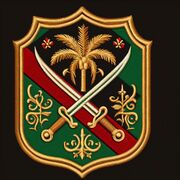Talk:Army of Burgundie
| Army Commands |
|---|
| Forces |
| Training and Doctrine |
| Materiel |
|- |
| Service components |
|---|
| Audonia |
| Crona |
| Kiro-Borealis |
| Levantine |
| Levantine Union |
| Punth |
| Sarpedon |
| Special Operations |
| Surface Deployment and Distribution |
| Space and Missile Defense |
| Cyber Command |
|- |
| Direct reporting units |
|---|
| Medical |
| Intelligence and Security |
| Criminal Investigation |
| Corps of Engineers |
| Military District of the Capital |
| Test and Evaluation |
| Military Academy |
| Reserve |
| Acquisition Management |
| Installation Management |
|- |
| Field Armies |
|---|
| First (Defense) |
| Second (Expeditionary) |
| Foreign (Expeditionary) |
|- |
| Branches |
|---|
| Acquisition Corps |
| Adjutant General's Corps |
| Air Defense Artillery Branch |
| Armor Branch |
| Aviation Branch |
| Army Band |
| Coastal Defense Artillery |
| Chaplain Corps |
| Chemical Corps |
| Civil Affairs Corps |
| Corps of Engineers |
| Dental Corps |
| Field Artillery Corps |
| Finance Corps |
| Inspector General's Corps |
| Judge Advocate General's Corps |
| Logistics Branch |
| Medical Corps |
| Medical Service Corps |
| Medical Specialist Corps |
| Military Intelligence Corps |
| Inspector General's Corps |
| Military Police Corps/Provost Gendarmerie |
| Nurse Corps |
| Ordnance Corps |
| Psychological Operations |
| Quartermaster Corps |
| Fire Seneschalcy |
| Signal Corps |
| Special Forces |
| Transportation Corps |
| Veterinary Corps |
Reorg
Three Combat Commands Foreign Legion (8 corps) focus: expeditionary warfare Metropole Forces (3 corps) focus: homeland defense/ready reserve Global Support Command (5 corps): humanitarian aid, troops for LUDC/LoN/allied nation mission/treaty requirements, and army-wide combat support and services units (Gendarmerie and field sustainment brigades will be subordinate commands) Burgundie (talk) 14:45, 15 July 2023 (EDT)
| Name | Headquarters | Strength |
| IV Ularien Corps | Alcairet | 25,890
Corps |
| Puhkgundian Gorkha Rifles | Salarive | 17,103
Division |
| XIII Flordeterran Division | Flordeterra, Equitorial Ostiecia | 15,123
Division |
| I Greater Levantine Division | Torlen | 13,447
Division |
| I Foreign Sustainment Corps | Equitorial Ostiecia | 32,220
Corps |
| TOTAL | 103,783 |
IV Ularien Division
Sometimes called the Burgoginesc Barsom Army of Ularia, or the Ularien Barsom Army in reference to its predecessor the 10,000 Moukahlas.
I Foreign Infantry Regiment
XIV Foreign Infantry Regiment
Umardi Askari Demi-Brigade
The Umardi Askaris are a unit of the Burgoignesc Foreign Legion formed of ethnic nomadic Umardi tribesmen from Umardwal who serve under Burgoigniac officers. It is the last and only segregated unit in the Army of Burgundie, with the codification of the roles of soldiers (lascarins) and officers being delineated by nationality and therefore race. Currently, the Demi-Brigade has 2,246 lascarins and officers and is based at Fort Safasi, Umardwal, the only unit in the Burgoignesc Security Forces permanently stationed outside of the territorial Burgoignesc thalattocracy.
Formed in 1723, the Askaris were a regiment in the colonial forces of the Ularien Trading Empire, who traced their roots to the Oduniyyad Caliphate’s invasion of southern Alshar in the YEARS. They served as the core of the colonial troops in the empire’s Audonian holdings, particularly since they were Shia and the remainder of the continent was primarily Sunni. This was part of the empire’s deliberate divide and rule policies that utilized religious, cultural, and tribal differences to advance the empire’s aims. After the collapse of the empire the unit was disbanded in 1842. The remaining Umardi Askaris were sent to various Burgoignesc Foreign Legion units and their history was all but forgotten. It was reformed in 1964 with the formation of the Islamic Republic of Umardwal when secular and non-Muslim nomads faced persecution at the hands of the Islamic Republics secret police. The nomads had strong connections with similar nomadic communities in Bulkh and Pukhgundi, the latter of which also joined the unit as they were facing similar persecution in their country.
The officers of the Askari’s are all recruited from the Provost Gendarmerie of Burgundie and serve as both officers and internal military police. This means the training is brutal and punishments for even minor infractions are severe. However, since the unit is one of the most active in the Army of Burgundie and because of its strict and martial command and lifestyle, the unit often performs well in overwhelming odds.
Fort Safasi is unique in that it has very few barracks buildings for the soldiers as they like to maintain their nomadic traditions which is encouraged as it supports a campaign lifestyle. It is also more of a community than a base as the families of the soldiers are as much a part of the unit as the soldiers themselves.
Kandaran Acinji String
The Kandaran Acinjis are a cavalry string specializing in armored warfare and armored reconnaissance. To accomplish their role, they are equipped with Cross Trucking Company AMX-10 RCRs and EBRC Jaguars.
Their role developed from its original form as Akinji at their formation in 1796, to the cavalry unit they are today. During the later years of the regime of the Burgoignesc Kandahar-Kandara Trading Company in Audonia, the late 18th and early 19th centuries, the Kandaran Acinjis were a reinforced regiment, often numbering over 6,000 men. Today, they are stationed in Joint Base ___, on Antilles. As of 1904, the unit was reduced to battalion strength (cavalry string), with 757 soldiers and officers.
Oyashimane Levy Regiment
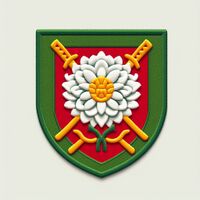
Sometimes called the Harimoto Ashigaru, or Maronnet's Mauraders is a light infantry regiment of the IV Ularien Division. It traces it's origins and traditions to the Burgoignesc colonial empire's Far East Colony, in modern day Oyashima.
Among its many units are the famed special operations D Company Ultra Light Urban Infantry, colloquially known as the "Parkour light infantry". This unit is trained heavily in the Shinobi arts, which can resemble to the modern layperson, free running or parkour. These soldiers are used in dense urban environments to seek snipers and anti-armor weapons teams. Their ability to scale buildings, move quickly and quietly through seemingly impassable avenues of approach, or to clamber over degraded infrastructure or rubble piles makes them especially feared.
Adaptive Urban Maneuvers: The unit leverages Shinobi/free running movement and climbing techniques in their tactical approach, enabling them to traverse obstacles, scale buildings, and navigate complex urban terrain with unparalleled agility, stealth, and speed. They adapt their movements to the specific layout of the urban environment, utilizing rapid route changes and improvised pathways to outmaneuver and outpace adversaries. These methods allow them to employ precision strikes and ambushes, capitalizing on their agility and speed to swiftly eliminate high-value targets or entrenched enemy positions. They employ hit-and-run tactics, quickly retreating into the urban landscape, making it challenging for adversaries to retaliate effectively. Building upon their mastery of deception and psychological warfare, the soldiers employ diversionary tactics, misinformation campaigns, and strategic distractions to confuse and disorient adversaries, creating opportunities for successful engagements and evasive maneuvers within the urban landscape by accompanying, traditional units.
They are also used by command for Intelligence Gathering and Reconnaissance. They use their advanced movement techniques and stealth capabilities to place surveillance equipment deep with enemy-held urban landscapes. The soldiers conduct thorough intelligence gathering and reconnaissance missions, collecting crucial information about enemy positions, movements, and vulnerabilities and relaying it back to the Regiments commanders. They utilize miniature drones, advanced vision enhancers, and covert surveillance techniques to gather real-time intelligence for strategic planning and decision-making.
They specialize in pistols, bladed weapons, and hand-to-hand combat.Drawing inspiration from traditional Shinobi and ninja techniques, the soldiers carry a variety of concealed bladed weapons, such as retractable combat knives and shurikens, for close combat and stealth assassinations. These weapons are carefully designed to be easily concealed within the soldiers' tactical gear.
The unit is also piloting and field testing the Multi-functional Electronic Reticle (MFER), a program that started started in 2029. These devices are a contact lens that is networked to interface with communication systems, GPS, and a limited HUD that commanders can push information to. These optical devices also have a built-in pulse sensor for monitoring vital signs during high-intensity operations.
Ularien Cuirassier Squadron

The Ularien Cuirassier Squadron, commonly referred to simply as the Cuirassiers, are equipped with the Cross Trucking Company AMX-10 RCR.
Ularien Cuirassier International Fraternal Units
The Ularien Cuirassier Squadron are fraternal with the Royal Arcerion Dragoons of the Arcer Army. They share the distinction of being the successor of heavy cavalry for their respective armies and as such they share a sense of that heritage and many common traditions. They hold an annual competitive joust an Barrel racing competition where in the units exercise equestrian sports appropriate to the role of heavy cavalry. In essence this translates to being equestrian sport that focuses on handling and short distance running, no activities relating to endurance running are conducted.
VII Foreign Engineer Regiment
XXIV Foreign Field Supply Battalion
IV Foreign Transport Battalion
XVII Foreign General Supply Regiment
XIII Equitorioise Brigade
Equitorioise Imperial Camel Constabulary

Imperial Camel Constabulary is a hussar demi-Brigade numbering 1,386 calvary men and officers. The unit is stationed across Equitorial Ostiecia. They are a combat unit, but when not actively deployed they supplement the local National Gendarmerie of Burgundie.
Cronan Alpine Infantry Regiment
Fianna Tauth Regiment
The Fianna Tauth (Eng. Tribes of Warriors), is an ancient military unit that predates Burgundie by centuries. The original Bergendii who settled Burgundie both fought and recruited the Fianna (Eng. warrior bands) throughout the nation's history. During the Great Confessional War, Burgoignesc aristocrats formed an army of the Fianna and were known throughout Kingdom of Dericania for their ferocity. In 1938, during the Second Great War a volunteer regiment was raised and sent to fight in Equitorial Ostiecia and became known as an Tauth (Eng. the Tribe). At the end of the war, they were given a permanent base in Flordeterra and build Fort Fearann na Treubh. Today, the regiment is 2,548 strong, whose mission primarily consists of Assault pioneers, but also has a strong logistics train that has been utilized by other Burgoignesc units operating in tandem with them.
Fianna Tauth International Fraternal Units
The Fianna Tauth are fraternal with the 211u Mechanized Brigade of the 21. Mechanized Division of the National Army Land Forces of Faneria. They share a historic Celtic heritage and many common traditions. They hold an annual Feis where in the Regiments exercise Gaelic arts – song, dance, drama, Fhasen language, traditional music, and Cluichí Gaelacha (particularly Gaelic football and Hurling).
CXLVII Foreign Combat Engineer Company
LXVII Foreign Engineer Battalion
XCII Foreign Alpine Engineer Battalion
LXXVII Foreign Field Sustainment Battaltion
IV Foreign Field Supply Battalion
LXXIV Foreign Transport Battalion
IX Foreign General Supply Regiment
Pukhgoignesc Gorhka Rifles Division
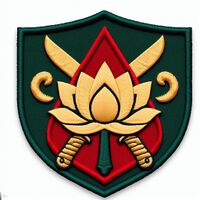
II Gorkha Parachutiste Regiment
IV Gorkha Parachutiste Regiment
VIII Gorkha Airborne Infatry Regiment
Airmobile mechanised inf
Zamburak Camel Artillery
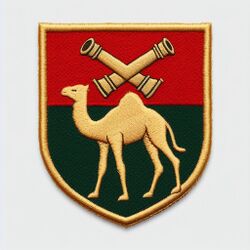
Seconded to the Burgoignesc Foreign Legion from the Puhkgundian Emirate in 1867 during the Emirati War. The Zamburaks were formalized into the Legion in 1915 as a mountain artillery battalion. During Operation Kipling the unit was bolstered into the 1st and 2nd Zamburak Camel Artillery Regiments. In 1986 the 2nd Regiment was disbanded and its artillerymen and equipment were seconded to the 1st Regiment which became just the Zamburak Camel Artillery Regiment. Due to the nature of the camel-borne transportation, the artillery used by the Zamburaks historically fulfilled the direct fire role and been of lighter caliber. During Operation Kipling the standard mounted weapon was a M40 recoilless rifle. In the modern era the unit has adopted the MMP, the Mistral, as well as the RTF1 (which gives it an indirect fire capability to the unit). While the camel is still the primary high alpine transportation method as well as the ceremonial transporter for the unit, the primary "lowland" vehicle of the unit is the DAGOR.
XXVII Gorkha Engineer Regiment
III Gorkha Assault Pioneer Battalion
XXII Gorkha Transportation Battalion
III Gorkha Support Squadron
XLIII Foreign Field Supply Battalion
I Greater Levantine Brigade
KilPatrick Ranger Regiment
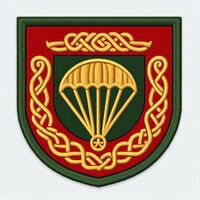
Paras
International Fraternal Units
The KilPatrick Ranger are fraternal with the Kinnaird Grenadiers of the Arcer Army. They share a historic Celtic heritage and many common traditions. They hold an annual Fèis where in the Regiments exercise Gaelic arts – song, dance, drama, language, traditional music, and highland games.
Raulie Bushrangers Regiment
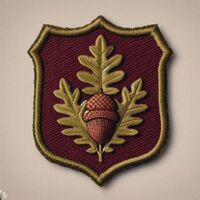
The Raulie Bushrangers are a series of decentralized Chasseurs Forestiers battalions that operate across the eastern hemisphere, primarily in Torlen, Alcairet, Chaukhira, Salarive, and Antilles. They are a form of military police and firefighting service, whose primary responsibility is maintaining the forests, highways and public lands in these provinces. They are an airborne assault regiment and in wartime provide advance guards and scouting parties. In total, the regiment consists of 7 battalions, totaling 4,584 men.
100 Chevaliers of Joanus
Main article: Knight of the Realm
The 100 Chevaliers of Joanus (Burg: Les Cent Chevaliers de Joan, commonly Les Cent Chevs) is an independent Assault pioneer company. They were originally raised in 1852 as a regiment of Yonderian mercenary cuirassiers in the First Fratricide. Their name is an homage to the Knights of the Realm (Burg: Chevaliers della reialme), but they are only spiritual successors of Siegmar von Willing's Black Company. The gens d'armes of the Black Company's success was noted by many not only for their military success, but also because they were not invested in the local politics and land squabbles. Being mercenaries they were classified as milites gregarii (non-noble cavalrymen). This helped maintain the fragile balances in the small courts of Kingdom of Dericania. As opposed to the milites nobiles (landed noble knights) or (Burg: Eques) who were constantly squabbling over land. For those princlings who could afford the services of the Black Company (Burg: Centes neirs), their services were crucial. The Vilauristre Conference and the Bishopric of Bonavix in particular used their services.
As the war expanded with the invasion of Vorenia by Bourgondi-Estie and Marialanus a larger army was needed quickly. Colonial units and mercenaries supplemented the counties militia. The reputation of the Centes neirs persisted through the ages and 300 years later another call was sent to the young men of Yonderre. 1,290 Yonderian Cuirassiers were recruited and trained under Bergendii officers.
